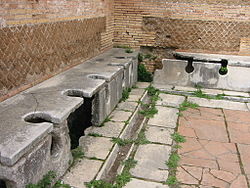


1) Bench
2) Main water channel
3) Front water channel
4) Wall
5) Window
6) Divider
7) Washbasin
A latrine is a toilet or an even simpler facility that is used as a toilet within a sanitation system. For example, it can be a communal trench in the earth in a camp to be used as emergency sanitation, a hole in the ground (pit latrine), or more advanced designs, including pour-flush systems.
Contents
The term "latrine" is still commonly used in military parlance, [2] and less so in civilian usage except in emergency sanitation situations. [3] Nowadays, the word "toilet" is more commonly used than "latrine", except when referring to simple systems like "pit latrines" or "trench latrines". [4]
The use of latrines was a major advance in sanitation over more basic practices such as open defecation, and helped control the spread of many waterborne diseases. However, unsafe defecation in unimproved latrines still remained a widespread problem by the end of 2020, with more than 3 billion people affected (46 % of the global population). Eradication of this public health threat is one of the United Nations' 17 goals for sustainable development. [5]
